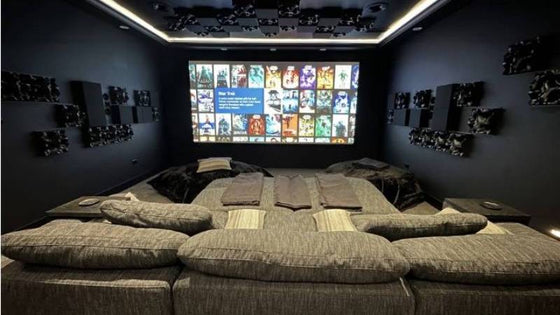Creating a system you love shouldn't be difficult. The Acoustic Frontiers blog is here to help.

This blog article is the sixth in a series on speaker directivity and off axis response. This article will consider the off axis response of omidirectional speakers (“omnis”) and consequences for acoustic design.
Previous articles in the series established the theoretical foundation in terms of the psychoacoustic as well as subjective importance of speaker off axis response and different ways to measure speaker directivity. We followed this up with articles that examined the specifics of:
The theoretical model for an omnidirectional speaker is a simple pulsating sphere that radiates every frequency from a point in space. Suffice to say there are no perfect omnidirectional speakers in existence, as it’s impossible at this point to generate a 20Hz sine wave from a small pulsating sphere! In reality even speakers marketed as omnidrectional only exhibit that characteristic over a portion of their passband.
MBLs Radialstrahlers are perhaps the most well known and highest end omidirectional speakers in existence today. Their lower end (still expensive) speakers incorporate only two omnidirectional drivers that cover the upper midrange and treble, whilst their higher end models include multiple units covering everything upwards of 100Hz. The MBL omni drivers are technologically quite interesting, being comprised of vertically oriented petals made from carbon fiber or aluminum affixed at the top and driven from the bottom with a typical moving coil assembly. More details can be found in this video.
Mirage make loudspeakers with drivers that fire onto lenses which disperse the sound very widely in the lateral plane. These speakers, like the MBLs, aren’t really true omnidirectionals in terms of their radiation pattern since they still have directivity changes in the vertical plane. B&O make some speakers that work along similar principles, using the lenses developed by Sausalito Audio Works. The characteristic of all these speakers is that sound pressure levels do not change laterally off axis, except for a drop off towards the rear due to enclosure shading.

Pretty amazing, huh? Whilst the off axis is not as smooth as that from say a YG speaker due to the small ripples that can be seen, there is no evidence of any narrowing in directivity as the frequency increases. Sound pressure levels off axis are the same as on axis.
The chart above shows the difference between the on axis response at 0 degrees and the response off axis at 60 degrees. You can see that the SPL levels are very consistent, save for the minor bumps and wiggles in this unsmoothed measurement. This is another good example of the off axis performance of an omnidirectional speaker.
It’s worth remembering that the performance of a loudspeaker is not just about the off axis. It’s a combination of a number of things. Many of the Mirage speakers have pretty poor on axis response with variations of 3-6dB within their omnidirectional working range!
Omnidirectional speakers put a lot more energy into the early and late reflected fields than other speaker types. This energy is spectrally consistent with the direct sound, especially in the lateral plane, and maybe also in the vertical depending on the speaker design. Spectral consistency is a good thing, since what you hear is the fusion of the direct and reflected sounds. See my article listening room reflections and the ETC for more about spectral consistency.
A frequent criticism of omnidirectional (and dipole) speakers is that imaging is vague compared to a traditional (box) speaker. The key early reflection point that’s responsible for this difference is the front wall behind the speaker. Comparing the amplitude and spectrum of early reflected sounds for a front firing box speaker and an omni will reveal the biggest differences from the front wall reflection. For a box speaker this reflection is mostly comprised of bass frequencies that wrap around the speaker baffle and bounce off the front wall (read about “baffle step” to understand this effect). It contains little mid and high frequency sound except that caused by diffraction off the baffle edge. In contrast the front wall reflection for an omni contains a lot of mid and high frequencies. What’s more this reflection is normally high in level relative to the direct sound, since the front wall is often the closest wall to the speakers. This front wall reflection arrives at listener’s ears from a direction which does not add much beneficially and should therefore be absorbed, redirected or diffused. If the energy return from the front wall is properly managed then the other early reflections can be considered and treated similarly to the acoustic design for a wide dispersion conventional forward firing cone/dome or coaxial speaker.
The late arriving field (otherwise known as the reverberant field) will be higher in amplitude for an omni than for all other speaker types. We perceive high levels of energy in the late arriving field as spaciousness, which is generally a good thing. Care should be taken to preserve the spectral balance of the late arriving field with all speaker types, but this is not a design consideration specific to omnis.
Thanks for reading this article, and next time we’ll look at dipoles! Be sure to leave your thoughts and questions below.
Learn how early home theater design, layout, and acoustic treatment improve performance in new home construction.
This media room was intentionally designed to feel like part of the home—not a separate, tech-heavy space. Through careful acoustic planning, equipment integration, and final calibration, we achieved a room that is both beautiful to live in and immersive to experience.
"No other subwoofer system I’ve owned even comes close to what this room delivers. Reaching out to Acoustic Frontiers was one of the best decisions I’ve made—I highly recommend working with them if you want to get the most out of your theater."

Nyal Mellor, Founder, Acoustic Frontiers



Nyal Mellor
Author